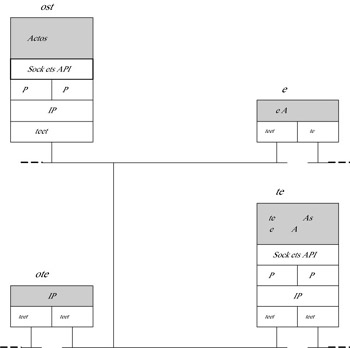Network Entities
|
| < Day Day Up > |
|
Finally, let’s review the types of devices found on the Internet and their roles in communication, routing, and hosting applications. See Figure 1.16 for graphical views of each of the devices.

Figure 1.16: Devices on the Internet.
Hosts
The host is the basic edge device on the Internet. It hosts a network stack and one or more applications that use the Sockets API to provide or use a service on the Internet. These applications could be client browsers or Web servers (utilizing HTTP).
Hosts can also be considered termination devices because they originate or terminate network connections (the boundaries of communication between two endpoints).
Bridges
The bridge is a specialized device that provides protocol-independent routing of datagrams. We refer to it as specialized because the routing algorithms occur at the MAC or data-link layer. For this reason, the bridge can route both IP datagrams and other types of packets, unrelated to the IP suite of protocols. With the ascent of wireless networks (using the 802.11 IEEE standard), bridge devices that bridge between typical 802.3 networks and 802.11 networks are becoming common.
Routers
A router is a specialized application that may run a particular version of an IP stack to route datagrams between two or more networks. Recall that routing occurs at the IP layer; therefore, it’s not necessary for the router to understand anything but IP. As shown in Figure 1.16, only the IP layer is present in the example stack. Because it does not originate or terminate connections, only the IP layer is necessary for the IP routing algorithm.
Gateways
The final device that we discuss is the gateway. This device provides the highest level of IP routing as it commonly inspects datagram packet headers in the transport header. For example, gateways can provide a firewall that is used to restrict access from the external Internet to nodes on the internal network. A gateway can also provide address mapping to hide internal network host addresses or share a single public address with many internal private addresses. This type of functionality is called Network Address Translation, or NAT.
A gateway may also provide higher-level routing algorithms based upon the application for which the frame is destined or originated. For example, a gateway may route Web server requests (HTTP) to one host and mail (SMTP) to another, even though their destination addresses are the same. This type of routing requires that the gateway deeply inspect the packet headers to understand the type of Application layer protocol being transported. Another important use of this type of routing is for system load balancing. For example, the gateway could route HTTP requests for images to one server and requests for HTML files to another. The ability to segregate traffic based upon the request can lead to better system performance (through limited file caching at the server) and can support transparent replication of content to multiple servers behind the gateway.
|
| < Day Day Up > |
|
EAN: 2147483647
Pages: 225